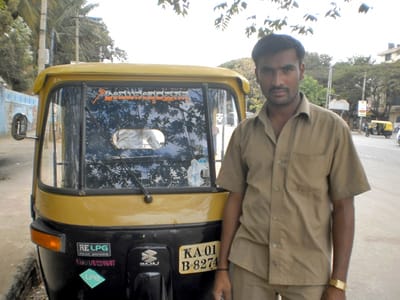The auto fares in Bengaluru have been revised as on 12 March, 2012. Are the auto drivers happy? No! Neither are the commuters. Around 2.5 years ago the minimum fare used to be Rs 14 and the Auto LPG gas price was Rs 37.33 per litre and now when the gas costs around Rs 49 per litre, the minimum auto fare still remains Rs 20.
But fare hike is not the only issue here.
Auto drivers refuse rides all the time
The auto drivers toil and work hard but most manage meagre earning of Rs 250 a day. The commuters however think they are being taken for a ride.

K M Manjunath. Pic: Abhishek Angad
They seemed to be annoyed with auto drivers about their attitude to such an extent that one of user’s update on Social Media website read, ‘Avoid Auto! Save Money! Take a bus! Wait a little’. Most commuters want to take his suggestion as they are livid over the attitude of the auto drivers. One can speak to any commuter and the angst against these auto drivers is palpable.
Abhijeet Anand, 28, an IT professional, who frequently travels by auto says, “one can understand the fare hike but these drivers blatantly refuse to go even for short distances. Even to long distances like HSR or outer ring road it’s hard to convince them. I stay at Koramangla and sometimes it is really difficult to get an auto ready to go exactly on meter. I am just upset over the services they provide.”
Last weekend alone Bangalore Traffic Police booked 3012 auto drivers for refusal to go on hire and demanding excess fare. Each of the 1968 cases for refusing and 1134 cases for demanding excess fare was fined Rs 100.

C Amravati, 35, tailor by profession often travels from Taverekare to RT Nagar by autorickshaw. Annoyed by the services she speaks, “even for short distances they charge minimum of Rs 30. Sometimes they don’t even understand the sense of urgency even if it is for hospital and they refuse. “
K Rahul, an IT administrator in a computer reseller’s shop seemed angry over the tampered meter. He told that he was unhappy about the hike but deeply sad about the way these drivers operate. He snapped, “almost on a daily basis I end up paying Rs 20 extra on meter for any destination. Apart from this the meter seems tampered. For the same destination fare varies.”
Auto drivers know it is hard on passengers
Auto drivers who spoke to Citizen Matters agreed the fare hike is not going down well with commuters. Saeed Shair Ali, a middle aged auto driver from Koramangala says, “I am not happy with the upward revision of fare. We survive on passengers using autos, this revision won’t make them comfortable. On the other hand there is no option left with us. The prices of gas has gone up, every time there is a price rise we spend around Rs. 500 to re-calibrate the meter. The burden seems so much.”
Autorickshaw driver’s union general secretary Manjunath says, “It’s just that the LPG auto gas prices have gone up we have to revise the fare. Drivers won’t survive as some drivers who don’t own the autos earn only Rs 350 a day. There is no facility from the government either for us.”
As soon as the LPG Auto gas price was revised the autorickshaw unions demanded minimum fare revised to Rs 24 amounting to Rs 12 per kilometer. But after several discussions and a strike, a common consensus reached out on Rs 20 as minimum fare.
K M Manjunath, 28, another auto driver and resident of Koramangala 1st block says, “It will not make a big difference on our income, as initially when minimum fare was Rs 17, people usually paid us Rs 20. Now, that the gas prices have gone up, it is getting a little difficult. They should have increased it to at least Rs 22 or more.” ⊕
Finally an article which tries to take a look from the auto-drivers’ perspective. It’s not easy being an auto-driver these days. Cost of living has also gone up and they need to feed their children too and send them to school. Apart from that, many who own autos also have to deal with collection agents from banks for the delayed installments for their loans.
Might be hard to explain why they refuse to go or why they ask so much, they are kinda linked. They refuse to go to places which are not lucrative (return fare difficult), and charge more for popular places so that they can maximise their earning.
Beyond that, the Govt does not help much either. Hare-brained ministers want to suddenly get all autos painted green or have all autos sport yellow tops. Each of this costs money in the 1000s. And then they decide to give 40K more permits as if we don’t have enough autos.
BMTC services have improved well for autos to know that they matter only for last mile connectivity. And that’s where they charge most money too.
Very rarely, if you are lucky, the autowallah will be ready to take you to the place of destination you want to go. Majority of the autowallahs can guess that you do not know the local language even though they can speak in your language too. Any arguement with them leads you into trouble. They are not afraid of police because they can always get away by paying mamools. Invariably, they charge more than what is shown in the meter and also will not return the balance saying they do not have change. Probably they were leeches in their previous birth.
Though I do agree that cost of everything has increased ,thanks to the non-existent Government, I will be happy if they charge by the meter and not harass the public by their standard intolerant behaviour. The days of gentlemanly behaviour is dead and gone.